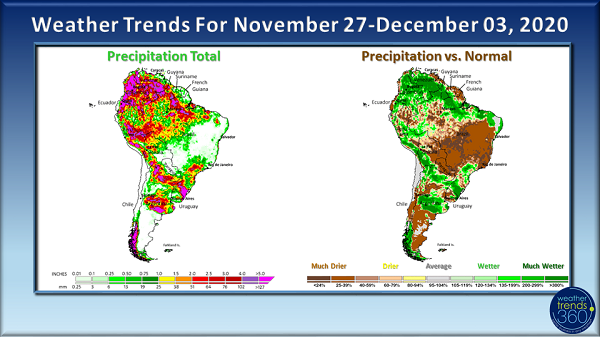RIO DE JANEIRO, BRAZIL – Rainfall was spotty over the seven-day period from November 20th to the 26th across Brazil and Argentina. This is not an encouraging signal as we are in the midst of a critical period and lacking rainfall will quickly build stress for corn and soybean growing areas in Brazil.
Looking ahead in the short term as we wrap up November and begin December, rainfall chances look to improve for portions of Argentina’s soybean growing region into southern Brazil, but rainfall deficits will continue across a large area of Brazil.

For the seven-day period of November 27th to December 3rd, precipitation will be well below normal in Mato Grosso, Mato Grosso do Sul, Goias, Minas Gerais, and Bahia.
Meanwhile, southern Brazil will see greater chances of showers. Long range forecast models suggest a slight moisture improvement for southern Brazil, however, timing of the rainfall will be almost as important as quantity.
Additionally, the northwestern corner of the state of São Paulo looks to remain very dry, which could have significant implications for Brazil’s sugarcane crop.
Showery weather will extend down into Argentina’s soybean growing regions. Wetter weather should help to improve moisture across the region, something that has been lacking across this area recently.
Looking long term, conditions may improve a bit for the harder hit soybean growing areas of Argentina, west of Buenos Aires.
Important Economic Pilar
Despite the crisis and the pandemic scenario, agribusiness has been showing positive results, helping to reduce the size of the Brazilian economy’s downturn in 2020; additionally, it should power the rebound, once it starts, according to figures from the sector and experts heard by UOL news site.
It was the only economic sector that had a positive result in Q1 2020 GDP. While industry and services contracted, agriculture and livestock grew 1.9 percent compared to the previous three months. The land generated R$120 (US$24) billion in revenues and by the end of the year, with record harvests, crops should yield R$697 billion.
In exports, the agricultural sector generated a net US$6.7 billion in gains in the trade balance between January and April, representing US$18.3 billion in shipments abroad and US$11.6 million in imports. Foreign sales rose 17.5 percent over the same period last year. Agribusiness participation in total exports rose from 18.7 to 22.9 percent in the four-month period ended in April.

